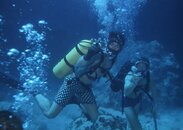James,
No, not true. The twin 72s in seawater were almost neutral, especially toward the end of the dive. They were well-thought-out dive cylinders, and not the hellaciously heavy steel cylinders of today. They universally had a J-valve in the manifold too. So four 72s would not be a great burden in the water (but getting out with them on would be a problem, even when I was young).
Now, about the using the J-reserve valve on different tank sets. I don't particularly like them on a single tank when I'm monitoring a SPG or dive computer, as the pressure will vary as I breathe. The variation has to do with the decrease in the HP coming into the regulator from the J-valve. You will see the needle drop and come back as you breathe. It is distracting.
But if you use a J-valve on a twins manifold, there is no needle drop. That is because only one cylinder has the air restricted. So what I have done is to use my SPG/Dive Computer in conjunction with the J-valve, and use the J-valve in the up position. I dive the scuba without using the J-valve, and it's there if I should need it. It is like having a bailout bottle, but more streamlined.
SeaRat




